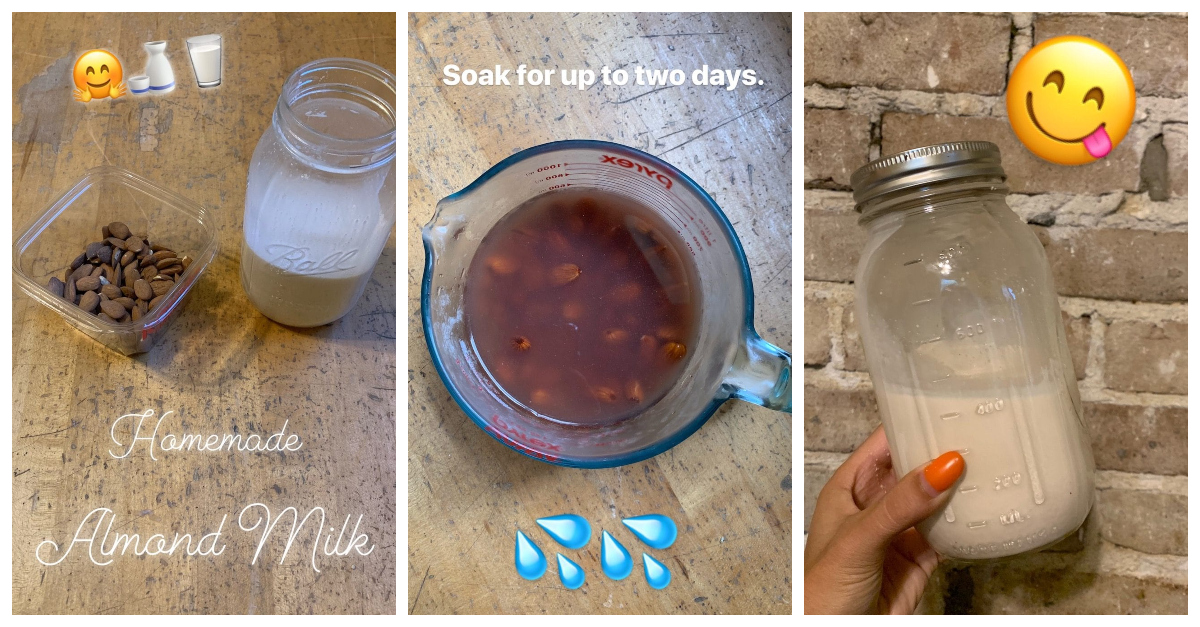
Nondairy milk alternatives are incredibly popular, and almond milk is one of the most popular of them all. It’s cheap, it’s available everywhere, and it tastes… well, it tastes OK. It’s not that great. It’s pretty bland. They say you can make your own homemade almond milk for a much yummier, creamier taste, and I recently tried to do it myself.
As someone who hasn’t had dairy milk since I was a child, I feel extremely qualified to do nondairy milk experiments. I used to buy almond milk regularly, back when it was the only option aside from soy milk at most grocery stores. But I stopped buying either of those after much tastier options became widely available — coconut milk, cashew milk, and oat milk, to name a few of my favorites. Mmm, oat milk.
I also use milk for a LOT of purposes: smoothies, cereal, tea, and more smoothies. That means I go through the stuff quickly, and all of the above milk alternatives are pretty expensive compared with almond milk.
So when I came across a recipe for homemade almond milk that was so simple I didn’t even have to write it down, I was pretty excited. It looked ridiculously easy and quick, which is all I ever want in a recipe. To make this milk, you need 1 cup of almonds, 2 cups of water, and some type of filtering material, such as a nut milk bag or cheesecloth. That is it!
Even better: My main problem with almond milk is that it’s watery and unbelievably bland, and this homemade version claimed to be neither of those things. Indeed, judging by the photos, it seemed much creamier.
But did my homemade almond milk live up to my expectations?!
The short answer is: YES. For the long answer, keep scrolling.
DIY Almond Milk

To make this recipe, I bought almonds in bulk at my local grocery store. I assumed the almonds would be cheaper from the bulk section, because isn’t everything? But upon further examination, it seems to be cheaper to buy a bag of almonds from the snack aisle. Just make sure the almonds are plain and raw, not roasted.
Homemade almond milk is inexpensive to make. It’s not, however, less expensive than store-bought almond milk, mostly because even the cheapest raw almonds are just not that cheap.
But on the other hand, homemade almond milk is 1,000% tastier than the store-bought kind. It’s also satisfying to make your own, to know exactly what goes into it, and to customize it to your own taste buds.
You need 1 cup of almonds for this recipe, which yields 2 cups of almond milk.
Step 1: Soak the Almonds

First I soaked 1 cup of almonds in filtered water. I left the almonds soaking overnight and most of the next day.

You can leave them soaking for up to two days; the longer you let them soak, the softer the almonds will be, which means creamier milk. If you’re in a rush, you can also soak the almonds for a couple hours in hot water.
Step 2: Dump the Water

When you’re ready to make your almond milk, dump the soaking water.
Step 3: Add Almonds to Blender or Food Processor

Add the almonds to a blender or food processor. Either machine will work just fine, though a high-powered blade is preferable. I used my friend’s Vitamix, and it worked great.
Step 4: Add Water and Blend

Add fresh filtered water to the blender. The recipe I used called for 2 cups of water, though I’ve seen other recipes call for more water. It’s pretty simple: If you use more water, your milk will have a thinner consistency. If you use less, it’ll be thicker.

I followed the 2-cup rule, and my almond milk was perfect. I blended it for about 1 to 2 minutes on high until it was smooth.

There will be chunks of almond meal left in the blender, which is normal.
Step 5: Filter

I used a strip of cheesecloth and placed it over a large cup. You can also use a nut milk bag, a dish towel, or any other porous material that’s large enough to squeeze with your hands.
Because once you begin to pour the milk mixture through the filter material, you’ll need to gather the sides of the filter together and squeeze it — milk it, basically — to get all of the liquid out.

I had to do mine in batches, because my strip of cheesecloth was nowhere near big enough! I also filtered my milk twice, because some of the nut solids fell into the milk while I was squeezing my tiny cheesecloth.
Next time, I’ll use something larger that can hold more mixture at a time.

When I was done, I ended up with roughly 2 cups of almond milk and a bag full of almond meal.

You can use the almond meal for smoothies, oatmeal, or muffins.
Step 6: Enjoy Within 2 Days

There is one downside to homemade almond milk, which is that it will keep in the fridge for only a couple of days. It has no preservatives and is not pasteurized.
That’s why this recipe yields only 2 cups — you really only need to make as much as you’ll use for the next two days.
The Results

All I can say is, MMM! Homemade almond milk is so much better than store-bought. I even made my girlfriend taste-test it, and she confirmed. It’s creamier, and it has an actual flavor instead of blandness. Some people add sweetener, a pinch of salt, cinnamon, or other flavoring ingredients to their homemade almond milk, but I honestly like mine plain.
I’m excited to use my DIY version in smoothies and cereal and all the other things that I use milk for — I’m sure my 2 cups of milk will disappear quickly.
Overall, the milk was really easy to make, too. Just soak, blend, squeeze, wash the dishes, and you’re done.
Now that I’ve mastered almond milk, I’d like to try making other types of homemade nondairy milk, too. Oat milk! Cashew milk! Coconut milk! All of the milks, here I come!




